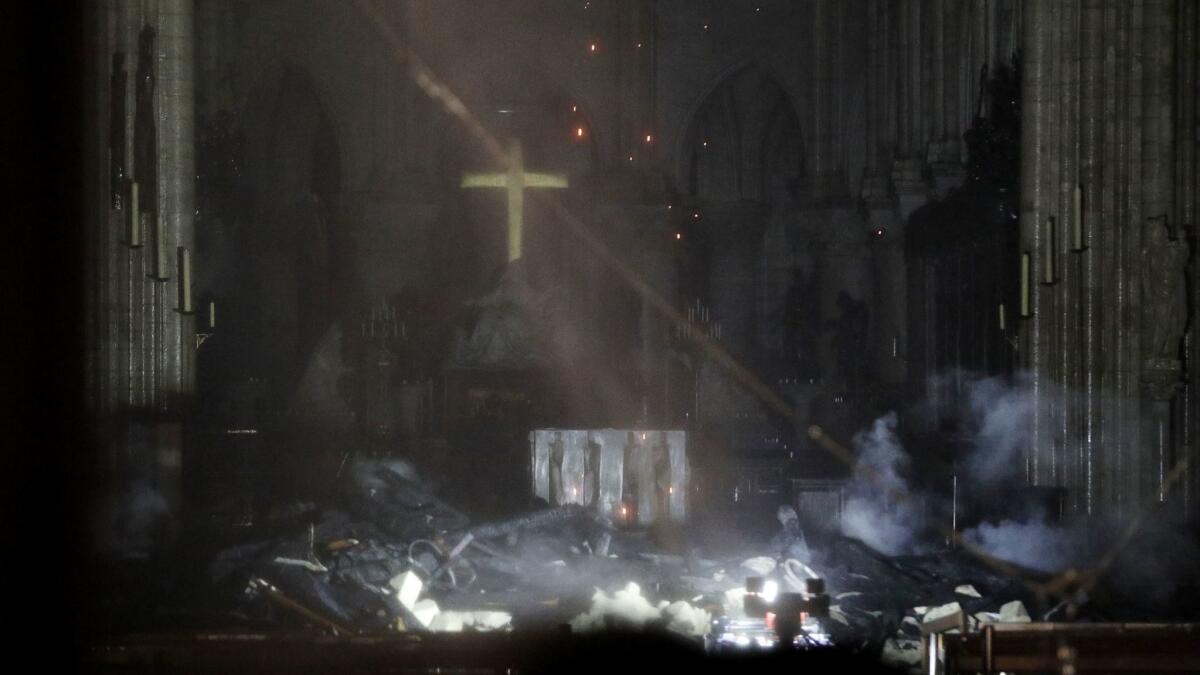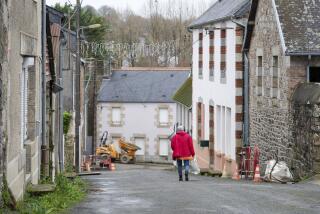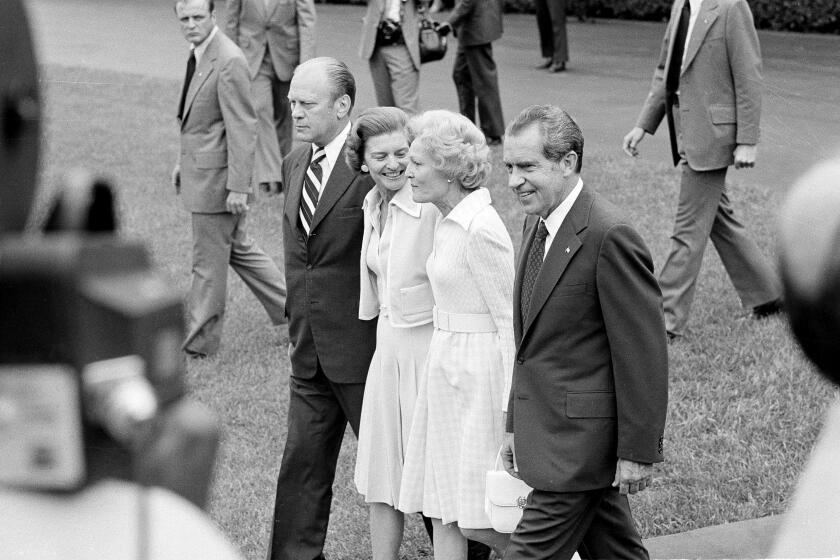Op-Ed: Notre Dame, France’s heart on fire

The words speckled my screen just before sunset: Incendie à Notre Dame, Christophe typed, fresh out of a daily contractor meeting for an office tower rising up on the south edge of Paris. Nothing had fallen yet. We both assumed it was a minor accident that the famous Pompiers de Paris would quickly quell. By the time my husband climbed up the metro stairs a half-hour later, flames had eaten the lead-sheathed wooden spire mounted atop the transept at the heart of the cathedral. By nightfall the central roof was gone. From our small sixth-floor balcony, I watched chimneys of orange smoke puff toward the sky until after midnight.
“Is there anything to be said about watching Notre Dame disappear?” a friend and colleague emailed. “I am just in tears — that beautiful building; the rose window I loved best in the world,” wrote another from Boston. “I read with horror that Notre Dame is on fire,” said a third, a Peruvian sound engineer I’d known in Washington.
For the record:
1:00 p.m. April 22, 2019An earlier version of this op ed misstated the year that World War II ended as 1944 ; it ended in 1945.
Paris is a noisy place. Motorcycles, clattering horns, amped up minstrel bands everywhere. “Silence. Just silence,” Christophe found as he walked down the hill toward the Seine and the smoke. “No one talked. Just standing there, hundreds of people. In shock, so many holding their heads in their hands.” Tears and silence.
Long described as the Catholic Church’s First Daughter, France is also known as the most secular country in Europe and possibly the West. At most, 5% of the population attends any service. Ancient churches here still draw crowds for Palm Sunday, Easter and Christmas Masses, but mostly the buildings are used for classical concerts now. Out in the countryside, village churches stand empty, offering three or four Masses each year attended mostly by elderly widows. At our place on the Loir River (a tributary of the more famous Loire), our sometime-neighbor priest serves 40 parishes.
Proudly secular, devout or joyously pagan, everyone for her own reason comes to Notre Dame, our mother.
This morning, the day after, gray and lightly drizzly, the pall of silence still hangs thick. Sidewalks along the Seine beside Notre Dame are packed. Voices, some seasoned by tears, are soft. TV cameras from around the world focus on the spire-less, roofless cathedral, its two medieval towers and rose windows barely touched, safe. Middle-aged men stand swallowing café express or beers. They try to talk about football, but the flat screens pull them back down the hill where fire trucks and their gargantuan hoses snake around the damaged walls, and they turn instead to “how long” the restoration will take and “how much” it will cost.
The two morning papers have their front pages covered with photos of the flaming, tumbling spire. On Libération, “Notre Drame.” On Le Parisien: “NOTRE-DAME DES LARMES” — tears. In the afternoon on Le Monde: “Notre Histoire.” On France Musique, the public classical music radio station, the entire day is given over to concerts celebrating the cathedral or recorded inside it. The apparent, hopeful news is that the enormous organ inside Notre Dame remains safe, if somewhat damaged by heat and smoke.
More than 13 million people a year pass through Notre Dame, almost half again as many as visit the Louvre Museum, and well ahead of the Vatican, St. Peter’s, Buckingham Palace or the Tower of London. On any given weekday afternoon, I find it nearly impossible to cross the plaza in front of Notre Dame on my bike as thick lines of largely Asian families wait to get inside.
What draws them here? Faith? Not much — not among the French or the foreigners. Architecture? The cathedrals at Reims (burned during World War I and rebuilt) and Chartres are far more exquisite. History? Perhaps. Notre Dame has stood on its little river island for nearly 800 years, survived earlier fires and revolutions, been stripped of its original Gothic statues and gargoyles and had them restored, all of it a sedimentary history of the lives, loves, hatreds and wars that set Paris apart from other places on the European continent and in the world.
Enter the Fray: First takes on the news of the minute »
Proudly secular, devout or joyously pagan, everyone for her own reason comes to Notre Dame, our mother. This space and its battered stones are and have long represented the spiritual center of the nation and the continent. Even in the heat of the 1789 Revolution, when the bishops allied themselves with the soon-to-be-headless king and the parish priests largely stood with the people, the revolutionaries hesitated to torch the altar, as the organist pounded out “La Marseillaise,” the revolution’s anthem. At the end of World War II, on Sept. 2, 1945, it was at Notre Dame, not the Champs-Elysées or the National Assembly or the Elysée Palace, where the French — communists, conservatives, socialists, Jews, Christians and Arabs — gathered at the ringing of the bells.
Comparisons to the burning and collapse of New York’s twin towers are inevitable, along with conspiracy notions that many will grind up for their own purposes. Both buildings stood as temples — one to world trade, the other to civilization. Nearly 3,000 died that day in New York. No one died in the burning of the spire of Notre Dame. It remains and will remain, not only as a church but as a monument harboring the heart of a people.
Frank Browning, a former NPR correspondent, has lived the last 20 years in Paris and is author of “The Monk and the Skeptic” and “The Fate of Gender.”
Follow the Opinion section on Twitter @latimesopinionand Facebook
More to Read
A cure for the common opinion
Get thought-provoking perspectives with our weekly newsletter.
You may occasionally receive promotional content from the Los Angeles Times.






